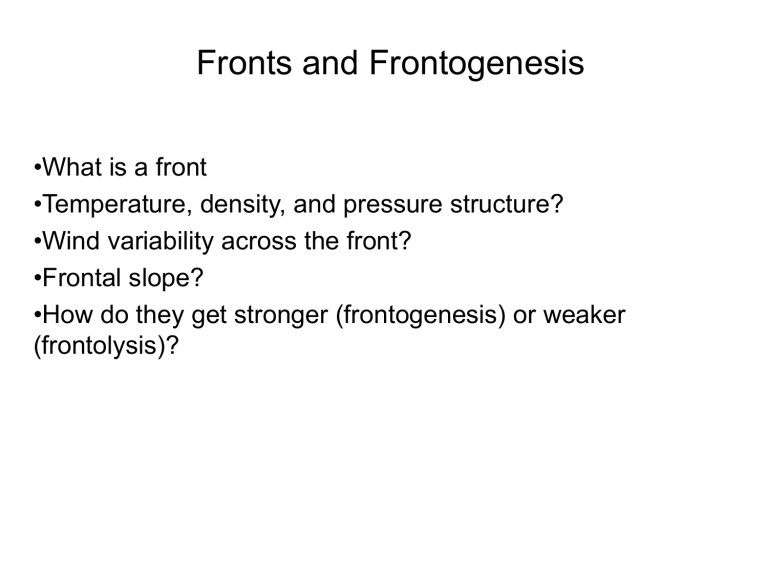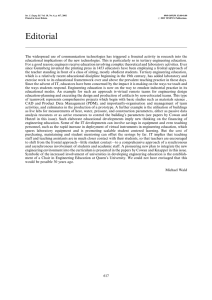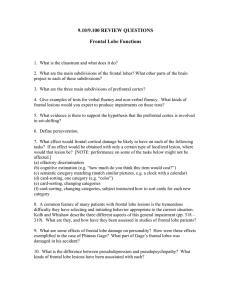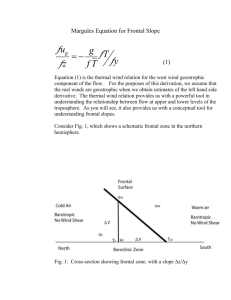
Fronts and Frontogenesis •What is a front •Temperature, density, and pressure structure? •Wind variability across the front? •Frontal slope? •How do they get stronger (frontogenesis) or weaker (frontolysis)? What is a front? •Defined: sloping zones of pronounced transition in the thermal and wind fields •They are characterized by relatively large: –Horizontal temperature gradients –Static stability –Absolute vorticity –Vertical wind shear •The along frontal scale is typically an order of magnitude larger than the across frontal scale: •Fronts tend to be shallow phenomena – depths of 1-2 km •They are observed at the surface and low levels and aloft near the tropopause as well •Why are they important: •Association with cloud and precip patterns •Rapid local changes in weather •Occur frequently with mid-latitude weather systems Frontal Structure •Let’s define a front as a boundary between two different air masses characterized by different densities •Then r is discontinuous across the front. •We know that pressure has to be continuous across the front, otherwise DP/d would be infinite (very strong wind) •Therefore, from the equation of state: P=rRT, if density is discontinuous and pressure is continuous across the front, then T must be discontinuous Frontal Slope •Let’s now ignore any along-frontal variation (in the x direction) and derive an equation for the frontal slope (dz/dy) Then, the change in pressure can be written as: P P dP y dy z dz (1) Dividing by dy gives: dP P P dz dy y z dy (2) From the hydrostatic equation, we know: p rg z So, substituting the hydrostatic equation into the equation for dP/dy gives: dP P dz rg dy y dy (3) Frontal Slope On the front, since Pressure is continuous, then Pc = Pw Therefore: dp dp dy w dy c (4) Substituting (4) into (3) gives: dP P dz r w g dy dy w y w (5) dP P dz r c g dy dy c y c (6) But, we know from (4) that (5)=(6) therefore, we can now solve for dz/dy: P dz P dz r c g r w g dy y c dy y w (7) P P dz dz r w g r c g dy dy y w y c (8) P P dz r w g r c g dy y w y c P P dz y w y c dy g r w r c (9) (10) Frontal Slope Now, since dz/dy is not equal to zero, and is usually > 0 (front slopes upward and to the north), then from (10): P P dz y w y c dy g r w r c (11) P P 0 y w y c or (12) P P y w y c (13) Frontal Slope So, while pressure is continuous across the front, the pressure gradient is not continuous across the front. Therefore, the isobars must kink at the front so that the above statement is consistent with the analysis: Horizontal winds across the front How do the horizontal winds vary across the front? Assuming that the flow is geostrophic and there is no variation in the y direction, the geostrophic wind can be written as: ug 1 p rf y (14) On the warm and cold sides of the front: u gw 1 p r w f y w (15) u gc 1 p r c f y c (16) P P dz y w y c dy g r w r c Substituting (15) and (16) into (17) gives: (17) Horizontal winds across the front dz r c fU gc r w fU gw dy g r c r w (18) or dz r f U gw U gc dy g r c r w (19) where r r c r w 2 Again, if dz/dy > 0, then Ugw – Ugc > 0 or Ugw > Ugc Therefore, cyclonic shear vorticity must exist across the front Here are some possibilities: Horizontal winds across the front Margules Equation for frontal slope Recall the equation for frontal slope: dz r f U gw U gc dy g r c r w (20) Using the equation of state, it can be shown that this equation can be written as: dz T f U gw U gc dy g Tw Tc (21) (21) is Margules equation for frontal slope Substituting in typical values: dz 10 4 s 1 300k 10ms 1 1 / 300 dy 10ms 2 10K This value is similar to what is observed (22) •Recall that our initial assumption was that density and temperature are discontinuous across the front •This is obviously not very realistic •In nature, frontal zones exist where: •T is continuous T is not y • •The frontal zone can be 1-10-100 km wide and is generally one order of magnitude small than the along-frontal scale: What do real fronts look like, anyway? •Note: sloping frontal zone to about 400 mb •Front is directly under the polar jet •Note the sloping frontal zone •Strongest near the ground •This front is shallow •Cyclonic vorticity across front •Large vertical wind shear and static stability through the front •From Keyser (86) •Notice how the front below strengthens from 12 to 00 UTC. •Why? From Keyser (86) •Vertical cross sections at 12 and 00 UTC: From Keyser (86) • 12Z: •Notice how diffuse the front is, also shallow •Weak front at this time due to radiational cooling differences on either side of the front – weakens the front •00 Z •Strong, sharp surface front at this time •Due to sensible heat flux difference on either side of the front •Note that the boundary layer is well mixed on both sides of the front How sharp can a cold front get? How sharp can a cold front get? Vertical cross section: •Note the extremely narrow frontal zone – on order of 1 km! •The front has “collapsed” to a very small across-frontal scale •How and why? – don’t know….. From Bluestein (92) Frontogenesis •Defined: the formation or intensification of a front •It may be described quantitatively through the frontogenesis function: F d dt p With a bit of math, F can be written as (assuming no along frontal variation and the front is oriented W-E): v Po 1 dQ F y y y p P c p p p p y p dt TERM I TERM II TERM III What is the physical interpretation of these three terms? v y p y p Frontogenesis •Term I = Represents the kinematic effect of convergence on the quasi-horizontal temperature gradient: •Term II = y p p Represents the tilting of isentropes: Frontogenesis Frontogenesis P 1 dQ •Term III = o P c p y p dt Represents diabatic heating/cooling: Or: •All of our discussion thus far has assumed that there is no variation of wind along the front. •What happens if we assume that there is along frontal variation by superimposing a stretching deformation field along the front: From Bluestein (92)


